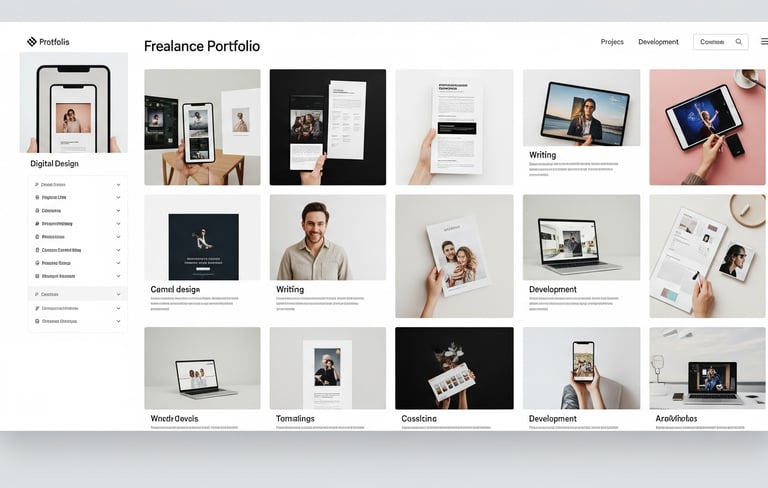How to Create a Freelance Portfolio That Wins Clients (Even With No Experience)
Dominate the freelance market! Build a powerful freelance portfolio that wins clients, even with no experience. Get essential tips on showcasing work, crafting engaging layouts, and optimizing for SEO to boost visibility. Start attracting ideal clients today!
Eddy Enoma
5/27/20259 min read
Understanding the Importance of a Freelance Portfolio
A freelance portfolio serves as a critical component in the journey of any independent professional, especially for those at the start of their careers. It is more than simply a collection of work samples; it is a powerful marketing tool that highlights an individual’s skills, experiences, and unique style. In today’s competitive freelance market, having a well-crafted portfolio is essential for attracting clients and establishing a credible presence.
One of the primary functions of a freelance portfolio is to showcase your skills effectively. For freelancers with limited experience, this can be particularly significant. By curating projects—whether they are actual client work, speculative projects, or personal endeavors—you can demonstrate your capabilities and creativity. As potential clients browse through your portfolio, they gauge the quality of your work and your ability to meet their needs. A strong presentation can convey professionalism and competence, building instant rapport with your audience.
Moreover, a well-structured portfolio extends beyond showcasing technical skills; it also serves to instill confidence and trust in potential clients. When one encounters a thoughtfully designed portfolio filled with compelling work, it fosters a perception of reliability. Clients often rely on visual evidence of your work, which is why it is important to tailor your portfolio to reflect not only the skills you possess but also your personal brand. This differentiation is especially crucial in a market saturated with freelancers vying for the same opportunities.
In essence, a freelance portfolio is an indispensable asset that not only highlights skills and experience but also differentiates freelancers in an increasingly competitive landscape. Effectively utilizing this tool can pave the way for securing clients and establishing a rewarding freelance career.
Identifying Your Target Audience
Defining your target audience is a crucial step in crafting a freelance portfolio that resonates with potential clients. Understanding whom you aim to serve will guide your decisions about the project types, visual style, and the message you wish to convey. It's essential to start by identifying specific demographics such as age, profession, and interests, as these factors significantly influence the preferences and needs of your audience.
Different niches require distinct approaches to portfolio presentation. For instance, a graphic designer targeting tech startups might showcase innovative designs that reflect modern aesthetics and functionality. Conversely, an illustrator focusing on children's books would benefit from a portfolio that features colorful and whimsical artwork. Therefore, delving into market research to understand your target audience's expectations is vital, as it will help you tailor your portfolio effectively.
Furthermore, recognizing the pain points and challenges your target clients face will enable you to position your offerings as solutions. Engage in conversations with industry professionals, read relevant blogs, and explore social media platforms to gain insights into your audience's needs. Use this information to highlight relevant projects that resonate with them and demonstrate your capability to meet their requirements.
Additionally, consider the format of your portfolio. A tech-savvy audience may prefer an interactive online portfolio, while more traditional industries might appreciate a classic PDF presentation. By aligning the format with your audience’s preferences, you demonstrate not only your skills but also your understanding of their expectations. Always remember that a well-defined target audience is the foundation upon which an engaging and persuasive freelance portfolio is built.
Collecting and Showcasing Your Work
Building a freelance portfolio is a crucial step for anyone looking to attract clients, even those who are just starting their careers. One of the most effective strategies for creating a compelling portfolio is to gather various work samples that highlight your skills. This can include both paid and voluntary projects, as each contributes significantly to your overall experience and skills showcase. Even if you lack formal employment experience, you can still present your abilities effectively.
Start by identifying any projects you have completed, whether they were for previous clients, internships, or even personal endeavors. If formal projects are scarce, consider creating mock projects that demonstrate your skills and creativity. These can be based on hypothetical clients or needs, and should reflect the type of work you aspire to undertake in your freelance career. For instance, if you are a graphic designer, create a few design concepts for brands you admire. This not only allows you to demonstrate your style and capabilities but also enhances your portfolio's depth with quality work.
When presenting your samples, quality is more important than quantity. Select the best pieces that showcase your range of skills and the outcomes you have achieved. Each sample should be accompanied by a concise description that outlines your role in the project, the challenges faced, and how your contributions helped the client or scenario. Additionally, consider creating a professional online presence to display your work cohesively. Websites, social media profiles, or design platforms can serve as effective platforms for showcasing your portfolio to potential clients.
By focusing on the quality and relevance of your work samples, and supplementing them with carefully crafted mock projects, you can create a freelance portfolio that makes a strong impression, even without extensive experience.
Crafting an Engaging Portfolio Layout
When creating a freelance portfolio, one of the foremost considerations is its layout. An appealing and user-friendly design can significantly influence potential clients’ first impressions. Various formats exist for presenting your portfolio, with websites and PDFs being the most popular options. A well-structured portfolio allows you to showcase your work effectively while also ensuring that visitors navigate through it with ease.
In a website format, choosing a clean and simple design is crucial. Opt for a template or theme that enhances readability, utilizing ample white space to provide breathing room for your content. Consider implementing a grid layout, which provides a visual hierarchy and organizes your projects neatly. Include an 'About Me' section prominently, as it allows visitors to connect with you personally. Here, you should narrate your background, skills, and any relevant experiences, even if minimal. This personal touch helps potential clients understand your journey and the value you can offer.
For those selecting a PDF format, ensure that the document is easy to navigate. A well-designed cover page, followed by a detailed table of contents, can significantly improve user experience. Each project should ideally be displayed on a single page with a brief description explaining the goals, processes, and outcomes of your work. Additionally, incorporating visuals such as project images, graphs, or charts can enhance the overall presentation and engagement level. Be sure to include contact information and encourage prospects to reach out.
Regardless of the format chosen, prioritize organization. Structure your portfolio logically, categorizing projects by type or industry. This systematic approach not only aids navigation but also allows potential clients to find relevant examples that resonate with their needs. Ultimately, your portfolio should reflect your creativity and professionalism, standing out in a competitive freelance market.
Optimizing Your Portfolio for SEO and Visibility
In today’s digital space, creating a freelance portfolio is not solely about showcasing your work; it must also be optimized for search engines to increase its visibility. Search Engine Optimization (SEO) is the process of enhancing your online content so that it ranks higher in search engine results pages (SERPs), thereby attracting potential clients. By integrating SEO best practices into your freelance portfolio, you can significantly improve your chances of being discovered by clients seeking your services.
First and foremost, effective keyword usage is fundamental in SEO. Begin by conducting thorough research to identify relevant keywords that potential clients might use to search for services similar to yours. For instance, if you are a graphic designer, terms such as "graphic design portfolio" or "freelance graphic designer" should be included throughout your content. Incorporate these keywords naturally in your project descriptions, headings, and even in image alt texts to enhance visibility without compromising the quality of your content.
Another critical aspect of SEO is crafting compelling meta descriptions. A meta description succinctly summarizes what your portfolio is about and appears under the title in search results. An effective meta description should be concise, include target keywords, and provide a clear value proposition to entice users to click on your link. Aim for a length of 150 to 160 characters to ensure that the entire description is visible in the SERPs.
Additionally, ensure that your portfolio content is organized and easily navigable. Structured content allows search engines to index your portfolio effectively. Implementing a clean layout with clear headings and subheadings will also benefit user experience, encouraging visitors to spend more time exploring your work. Regularly updating your portfolio with fresh content, such as new projects or case studies, will signal effectiveness to both users and search engines alike, making SEO a continuous process to engage potential clients.
Gathering Testimonials and Building Credibility
When embarking on a freelance career, establishing credibility can often be a challenge, especially if one lacks a substantial portfolio or client history. However, testimonials play a significant role in overcoming this hurdle. They serve as social proof, showcasing your skills and reliability to potential clients. A well-crafted testimonial can greatly influence a decision-maker’s choice, as they often seek reassurance through the experiences of others.
To gather testimonials, first, consider reaching out to previous colleagues, instructors, or even friends who can speak positively about your skills. If you have completed projects or tasks, even in a non-professional context, ask those for whom you worked if they would provide feedback on your performance. This creates opportunities for you to collect authentic testimonials that reflect your abilities.
When requesting testimonials, it is important to be specific about what aspects you would like the testimonial to focus on. This may include your problem-solving abilities, communication skills, or the quality of your work. Providing guiding questions can help your clients articulate their thoughts more effectively. Additionally, consider suggesting a framework for the testimonial, helping ensure that the response is both relevant and impactful.
Once you have collected testimonials, displaying them prominently within your freelance portfolio is crucial. Create a dedicated section for testimonials, or incorporate them naturally throughout your portfolio. Use formatting strategies such as quotes or highlighted text boxes to make these testimonials stand out. Visual appeal can help to attract attention, making the testimonials more memorable to potential clients.
In conclusion, gathering testimonials is a vital step in building credibility as a freelancer. By leveraging social proof strategically, you can enhance your portfolio, providing potential clients with the assurance they seek in choosing you for their projects.
Next Steps and Continuous Improvement
Creating a freelance portfolio is merely the first step in an ongoing journey towards attracting clients and advancing your career. To maintain relevance and showcase your evolving skills, it is essential to revisit and update your portfolio regularly. Set a schedule, perhaps quarterly or biannually, to review and refresh your work. This practice not only highlights recent projects but also demonstrates your growth and commitment to quality.
Continuous improvement should also involve seeking feedback from peers, mentors, or even clients. Constructive criticism can provide invaluable insights into how your portfolio is perceived and what adjustments might enhance its effectiveness. Engaging with your network to gather diverse perspectives allows you to refine your presentation and ensure it resonates with potential clients. Consider asking specific questions about the clarity of your message or the appeal of your showcased works.
In addition to updating your portfolio, investing time in ongoing learning is crucial. The freelance landscape is constantly evolving, and staying on top of industry trends can set you apart from the competition. Platforms like Skillshare, LinkedIn Learning, and Codecademy offer flexible online courses tailored to freelancers. You can also tap into valuable insights through free webinars from NextUp and FindCourses, which cover a wide range of professional skills. Additionally, books like Survival Skills for Freelancers by Sarah Townsend and Company of One by Paul Jarvis offer timeless strategies to help freelancers thrive. Integrating these new skills and knowledge into your portfolio not only increases its appeal but also reflects your adaptability and commitment to growth.
As you navigate these steps, remember that assistance is always available. For those seeking professional guidance in portfolio design and optimization, numerous freelance services can offer tailored support. Collaborating with an expert can facilitate the creation of a compelling portfolio that reflects your unique strengths, ultimately accelerating your success as a freelancer. By committing to continuous improvement and actively seeking opportunities for advancement, you position yourself for long-term success in this competitive field.


Creating a standout freelance portfolio is crucial for showcasing your best work, attracting ideal clients, and commanding higher rates. In this guide, we've curated the top strategies and tips to build an impressive portfolio that highlights your skills and experience. From selecting your strongest projects to crafting compelling case studies, these freelancer-approved resources will help you make a powerful first impression and stand out from the competition.
We encourage you to explore these strategies in detail and consider how they can enhance your specific freelance business. Whether you're a writer, designer, developer, or consultant, a well-crafted portfolio can significantly boost your credibility and earning potential.
Additionally, if you'd like personalized recommendations or support tailored to your unique freelance needs, we invite you to explore our specialized freelancing services. Our expert guidance can help you optimize your portfolio, attract more clients, and scale your business with confidence.
Ready to elevate your freelance career? Subscribe to our newsletter for expert tips on attracting clients and building a thriving portfolio!
Subscribe for Exclusive Tips & Updates. Enter Your Email Below!



Get the latest strategies on content creation, freelancing, and affiliate marketing, plus passive income straight to your inbox!
🔒 We respect your privacy. Your email is safe with us. Unsubscribe anytime.
Address
Sporerweg 16
94234 Viechtach, Germany
Contacts Us
(049) 170 499 6273
Subscribe to our newsletter
© 2026 Onlinebizoffers. All rights reserved.




